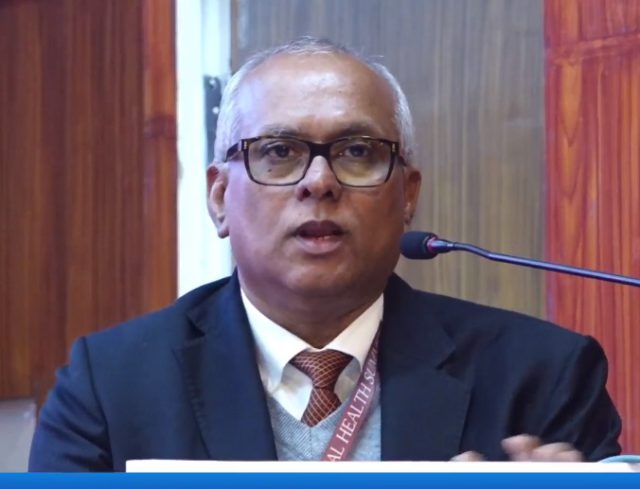‘Quality of Care an Essential part of Universal Health Coverage’

Thank you for inviting me to speak on the important topic of “Quality of Care an Essential part of Universal Health Coverage”
Even with increased access to services, health improvements can remain elusive unless those services are of sufficient quality.
I will start with a heartbreaking example of Martha Mills, a young girl aged 14, who lost her life owing to failures in her treatment at King’s College Hospital, London. Martha’s death was preventable. An inquest said Martha could have survived had her care been better. The hospital has admitted mistakes were made.
In 2021, on a family holiday, Martha slipped on to the handle bars of her bike, and injured her pancreas. During the time Martha was in hospital, no consultant had overall care of her, and the senior doctors did not document her condition. Every day a different consultant visited the ward. Her family always by her side were the only one’s alert to her trends. Nevertheless, the King’s doctors never gave them the full picture and withheld information about her deteriorating condition. Even when the doctors knew she was in severe sepsis they failed to escalate her to paediatric ICU.
Her parent’s despite their worries were reassured time and again it was “just a normal infection”. On the fateful weekend while the consultants discussed Martha’s severe sepsis among themselves, they did not alert her parents. She had very low blood pressure and, later, a rash, which the registrar misdiagnosed and concluded it wasn’t caused by sepsis.
Although Martha met all the criteria for immediate escalation to ICU, she stayed on the ward. The duty consultant, at home, failed to draw up a plan for her care that day. No doctor visited Martha overnight. The duty consultant said “categorically” that a bedside visit from a member of ICU shouldn’t happen – it would increase her parent’s anxiety.
Only after Martha had a fit in her mother’s arms that she was finally transferred to intensive care. Once she began to go into septic shock, no recovery was possible.
Martha’s case puts a spotlight on various aspects of quality of care. These include patient safety and most importantly, it shines light on the importance of listening to patients and their families. We, or someone we love, will be in hospital at some point in our life. All of us will know families describing their powerlessness when loved ones are admitted in hospitals. Questioning medics is daunting. Doctors should welcome input from patients, their family members and carers . They should also welcome a second opinion from a colleague of any rank.
Universal health coverage is at the forefront of global health. It means that all people have access to the full range of quality health services they need, when and where they need them, without financial hardship. Quality health services is embedded within the definition of UHC.
UHC cannot be achieved without attention to quality of care in all settings including under fragile and conflict conditions. Quality is a multidimensional concept. It covers promotive, preventive, curative, rehabilitative and palliative care. Determinants of health such as catastrophic health expenditure, cost containment, out of pocket expenditure, road infrastructure, transportation, water, sanitation, hygiene have critical linkages to quality of care.
Quality health services should be: ethical; safe; effective; people-centred; timely; equitable; integrated; efficient and affordable.
Inadequate quality results in avoidable mortality, human suffering and significant economic losses. According to estimates:
The occurrence of adverse events due to unsafe care is likely one of the 10 leading causes of death and disability in the world.
Globally, as many as 4 in 10 patients are harmed in primary and outpatient health care. Up to 80% of harm is preventable. The most detrimental errors are related to diagnosis, prescription and the use of medicines.
Globally, the essential structures for achieving quality care are inadequate: one in 8 health care facilities has no water service, one in 5 has no sanitation service, and one in 6 has no hand hygiene facilities at the points of care.
Sixty per cent of deaths in LMICs from conditions requiring health care occur due to poor quality care, whereas the remaining deaths result from non-utilization of the health system.
Each year, 134 million adverse events occur in hospitals in low- and middle-income countries (LMICs), due to unsafe care, resulting in 2.6 million deaths (4).
Inadequate quality of care imposes costs of US$ 1.4–1.6 trillion each year in lost productivity in LMICs.
In high-income countries too, it is estimated that one in every 10 patients is harmed while receiving hospital care. The harm can be caused by a range of adverse events, with nearly 50% of them being preventable.
In OECD countries, 15% of total hospital activity and expenditure is a direct result of adverse events.
Investments in reducing patient harm can lead to significant financial savings, and more importantly better patient outcomes. An example of prevention is engaging patients, if done well, it can reduce the burden of harm by up to 15%.
Governments, health systems, citizens, patients and health workers need to work together to achieve the goal of quality health service delivery at the front line. Improving the quality of health services requires strong national direction from governments, focused sub-national support, and action at the health facility level. Across all levels there is a need for engagement and empowerment of the communities served by the health system.
National policies and strategies aimed at improving quality of care provide a strong foundation for improving quality across the health system and need to be closely aligned with broader national health policy and planning.
At the heart of national quality policy and strategy is a pragmatic package of interventions reflecting the action needed across the health system to shape the system environment, reduce harm, improve clinical care, and engage patients, families and communities.
The provision of quality services requires good governance; a skilled and competent health workforce; financing mechanisms that enable and encourage quality care; information systems that continuously monitor and learn to drive better care; medicines, devices and technologies that are available, safe and appropriately regulated; and accessible and well-equipped health care facilities.
Primary health care is central to delivering high-quality universal health coverage. The three interrelated pillars of primary health care – empowered people and engaged communities; multisectorial action for health; and health services that prioritize the delivery of high-quality primary care and essential public health functions – all require careful consideration of quality.
PHC orientated health system strengthening can serve to enhance both service quality and address structural discrimination, as effective PHC tackles the root causes of poor health, embodies social justice, engages in intersectional and multispectral approaches, and empowers communities.
PHC-oriented health systems are health systems organized and operated so as to make the right to the highest attainable level of health the main goal, while maximizing equity and solidarity. Social determinants influence risks for ill health, health-seeking behaviors, access to healthcare and positive treatment outcomes, as well as trust in and acceptance of healthcare systems, providers and treatments.
The differing needs of subpopulations must be considered when designing and delivering health services as the quality of healthcare experienced is determined by how well an individual’s needs are met.
Quality needs to be continually measured and monitored to drive improvement. This relies on accurate, timely and actionable data. This includes adverse event reporting.
Equity-oriented health information systems and barrier assessments can identify factors that influence suboptimal quality of care, which is disproportionately experienced by disadvantaged subpopulations, and inform the development of health policies and services that address inequities.
Quality and resilience are closely linked. For health systems to be resilient, they require quality health services that are delivered prior to, maintained during, and improved upon following a public health emergency. Quality health services are pivotal during emergencies and serve as the interface between communities and the health system.
Quality services need to be delivered with compassion, focused on the needs of people and communities.
Patient safety is fundamental to delivering quality essential health services. Safety of patients during the provision of health services that are safe and of high quality is a prerequisite for strengthening health care systems and making progress towards effective universal health coverage (UHC) under Sustainable Development Goal 3.
Successful implementation of patient safety strategies requires clear policies, leadership capacity, data to drive safety improvements, skilled health care professionals and effective involvement of patients in their care.
To err is human. A mature health system takes into account the increasing complexity in health care settings that make humans more prone to mistakes. Humans are guarded from making mistakes when placed in an environment where the systems, tasks and processes they work in are well designed. This requires open and transparent environment where a safety culture prevails.
Every year, millions of patients suffer injuries or die because of unsafe and poor-quality health care. Some of the patient safety situations causing concern include: medication errors; health care-associated infections; Unsafe surgical care procedures; Unsafe injections practices; Diagnostic errors; Unsafe transfusion practices; Radiation errors; Sepsis and Venous thromboembolism (blood clots).
It is also important to recognize the impact of patient safety in reducing costs related to patient harm and improving efficiency in health care systems. The provision of safe services will also help to reassure and restore communities’ trust in their health care systems.
Ethics and equity are intrinsic to quality. Attention to equity as a key dimension of quality is critical for successful resilience and recovery, as well as for ongoing preparedness and response to health threats. Unless ethical services that do not vary in quality on account of age, sex, gender, race, ethnicity, geographical location, religion, socioeconomic status, migrant status, disability, language, sexual orientation, political affiliation and other factors are in place universal health coverage will remain an unrealized dream.
Healthcare markets are imperfect. Healthcare providers will always know better about quality than those seeking care. There is a risk that quality will be underprovided. This requires systematic investments in improving regulation of the quality of care in both the public and private sectors. The expansion of the private sector in the past decades necessitates governments to develop effective and appropriate regulatory mechanisms to ensure quality and control costs.
Building health literacy in the community is key to improving quality and ensuring accountability.
Human Resources for Health underlie quality and service delivery improvements. Without adequate investments in improving and expanding health professional education, making and sustaining gains will be unlikely.
Finally Embedding Quality Within Universal Health Coverage requires health services are:
Ethical and compassionate
Safe by avoiding harm to the people for whom the care is intended;
Pffective by providing evidence-based health care services to those who need them;
People-centred by providing care that responds to individual preferences, needs and values, within health services that are organized around the needs of people;
Timely by reducing waiting times and sometimes harmful delays for both those who receive and those who give care;
Equitable by providing the same quality of care regardless of age, sex, gender, race, ethnicity, geographic location, religion, socio-economic status, linguistic or political affiliation;
Integrated by providing care that is coordinated across levels and providers and makes available the full range of health services throughout the life course; and
Efficient by maximizing the benefit of available resources and avoiding waste.
Affordable: Reducing the Financial Burdens of Health Care. Out-of-pocket (OOP) payment is the most inequitable and inefficient method for health care financing, often leaving vulnerable patients without access to care and further impoverished.
Thank you
(#Keynote Speech by Dr. Rajesh Sambhajirao Pandav, WHO Representative to Nepal at the 3rd NMA National Health Summit 2023 on 26th November, 2023)
सम्पर्क इमेल : nepalihealthnews@gmail.com




















